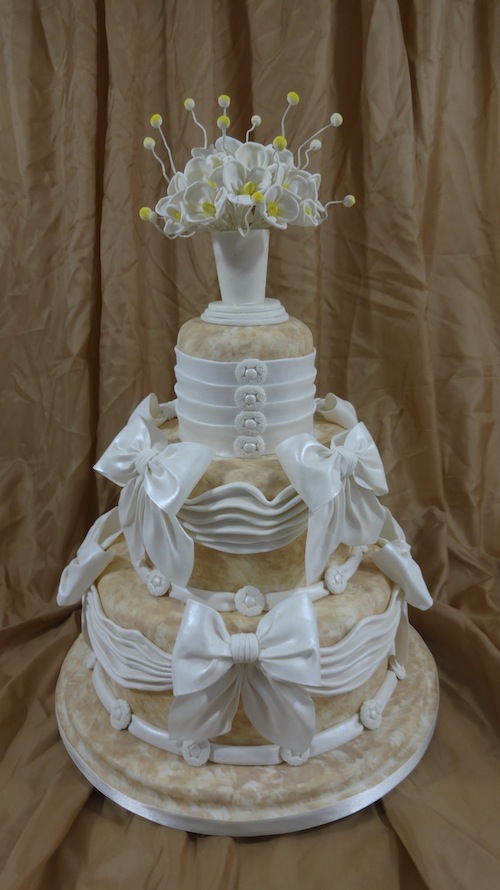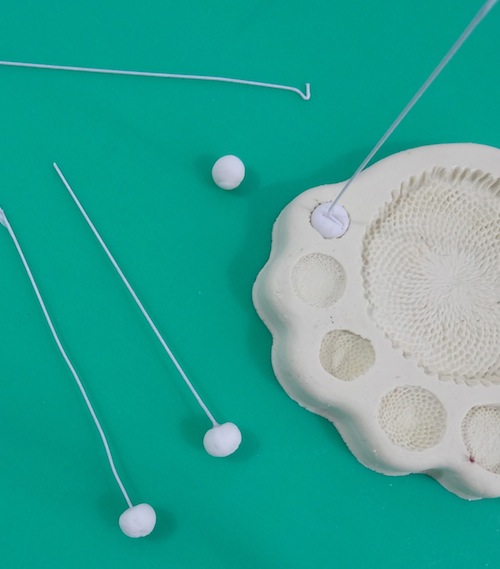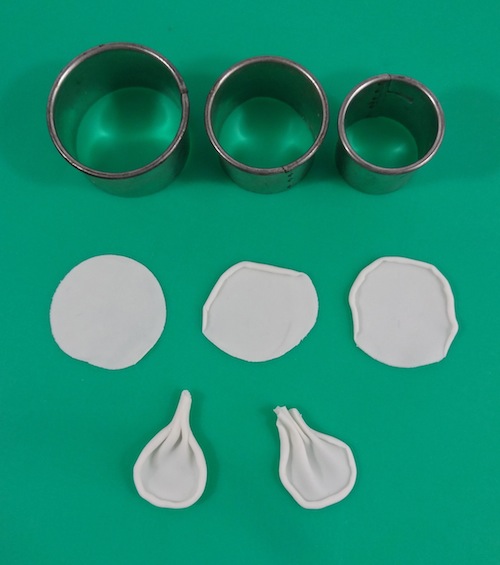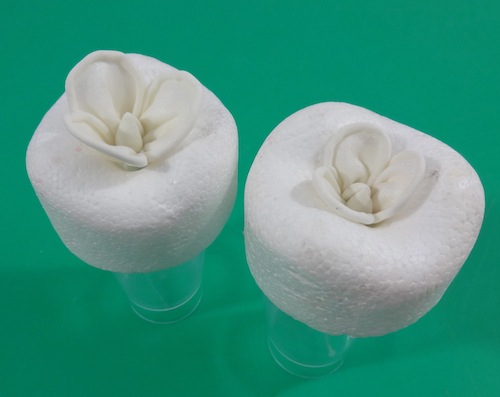[box type=”shadow”]This guest post is written by renowned sugarcraft artist Gary Chapman, instructor of the Bluprint class Rolled Fondant Flowers. In this tutorial, he walks through the process of creating wired sugar flowers for a beautiful bouquet.[/box]

Sometime in 1994, I had the privilege of meeting Cile Bellefleur Burbidge in London. My journey into the mysteries of cake decorating was in its early days and I was thrilled when she gave me a copy of her book, The Fine Art of Cake Decorating. I have never forgotten our meeting because she was wonderful company, amazingly modest and kind, not to mention a talented cake decorator.
Cile was undoubtedly one of the most influential, creative and important cake designers of her day and was renowned for the excellence of her piping skills, since in the USA, rolled fondant work was virtually non-existent and buttercream the pre-eminent medium.
Her legacy is sadly not as visible as it should be today as her rise to prominence was before the advent of the Web and so few photographs of her work surface.
Cile influenced me to make a splash on the top of a cake.
Since then, this had been one of my favorite design elements.
There are countless ways of making the vase itself and one common method is to use powdered sugar with a little water molded into a cup of suitable size and shape. After allowing to dry, tap out and evolve the vase with fondant or use royal icing or buttercream to pipe a final covering.
I now use a strengthened paste mix and a range of plastic or ceramic containers to make my vases. They are for me a wonderful flourish to the top of the cake and for wedding cakes, make a perfect memento for the happy couple. Also, in the UK, we are not allowed to place wire into a cake, so a vase is a perfect frame for wired sugar flowers.
Here’s how to make wired sugar flowers and a simple sugar vase:
These sugar blooms are just one of the techniques I teach in my class Rolled Fondant Flowers.
First, make the sugar vase.
Step 1:
Add a small amount of Tylose powder to Wilton rolled fondant — this will make the paste harden firmly.
Step 2:
Grease the inside of the plastic container to create the vase with a little white vegetable fat.
Smooth about half of the paste into a ball with no creases or marks and place inside the container.
Gently hollow the paste and smooth against the side of the container. Use a ball tool to ensure there is a good sized hollow. If there is any excess at the top, cut off neatly.
Leave to dry for a few days.
Step 3:
Heat the container in boiling water, dry and gently ease the paste out of the container.
Leave to dry again until absolutely hard.
Step 4:
For the base, roll out a big sheet of the paste at least 3mm thick and cut out three circular shapes: 7.5cm, 6.5cm and 5cm. The top and middle layer have the center cut out; the bottom layer does not. The vase should fit in this space.
Allow these three layers to dry for a few days.
Step 5:
Once dry, assemble all pieces very carefully and glue with royal icing.
Then, make the flower “balls.”
Step 1:
Create at least 16 small balls out of gum paste.
Step 2:
Create a hook in 26g wire.
Step 3:
Place each ball in a flower center former.
Step 4:
Dip the wire in a little sugar glue and then insert into the ball and pinch the paste to the wire.
Leave to dry for at least a day
Step 5:
Once dry, dust lightly with sunflower dusting powder.
Now, work on the flower centers.
Step 1:
Create at least 30 balls of gum paste (each about 1.5cm long) for the flower centers and shape into a teardrop shape with a pointed end.
Step 2:
Create a hook in 26g wire.
Step 3:
Dip the wire in a little sugar glue and then insert into the flower center and pinch the paste to the wire at the base.
Step 4:
Cut with a small pair of scissors and the accentuated the “cut” with a cocktail stick.
Leave to dry for at least a day.
Step 5:
Once dry, tape all the wire with white floral tape.
Time to make the “blossom” flower petals.
At least 30 blossoms are needed in three sizes using gum (flower) paste. They are all made in the same way and there are three petals per blossom. The petals are made using three circular cutters 3cm, 4cm and 4.5cm (small, medium and large).

Step 1:
Roll out a thin sheet and cut out three circular shapes and then roll the edge using your thumb and forefinger (do not fold, but roll up). Roll into a neat shape but leave a third untouched for the base.
Step 2:
Pleat this base and then pinch and seal the end.
Lastly, make the “blossom” fabric flowers.
Step 1:
Using a paintbrush, add a little sugar glue onto the base of the flower center. Very carefully paint a little glue on the base and the side of each petal.
Step 2:
Hold the wire with the flower center at the bottom with one hand and then add the petals one by one.
For the small flowers, which are more like buds, overlap each petal and allow to look more closed.
For the larger flowers, add the petals one by one to the center, but do not overlap. Pinch the sides together. Invert and place in polystyrene flower formers to dry. Adjust the petals to ensure they have a more concave shape.
Allow to dry for at least a day.
Step 3:
Once dry, dust with white satin luster dust and a little sunflower yellow on the centers.

[box type=”shadow”]
About Gary Chapman

Gary Chapman lives in Stroud, England, teaches all over the world and serves as a competition judge throughout Britain. Gary developed an interest in sugarcraft in the early 1990s when he joined Merehurst Publishing Company, a leading publisher of cake decorating books. Sugarcraft offered him a new artistic expression that he hadn’t experienced since he was young and was artistic with modeling clay, painting and drawing. Gary helped launched Merehurst company in the U.S. at the ICES shows and raised the profile of many leading decorators. Invigorated by this exciting edible art medium he set up Iced Delights in the early 1990s, invented the fabric-effects technique, published his own book Fabric Effects in Sugar and gave demonstrations and classes all over the U.K. and the U.S.[/box]






Share tips, start a discussion or ask one of our experts or other students a question.
No Responses to “Make a Beautiful, Edible Bouquet With Gary Chapman”